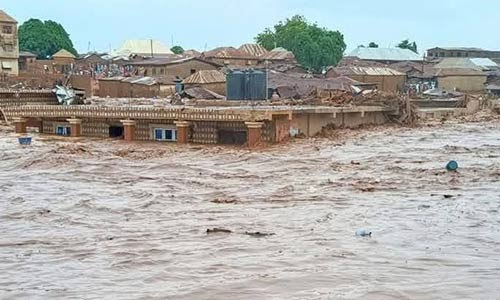The Federal Government has dismissed speculations that the recent devastating flood in Mokwa, Niger State, was triggered by a failure or release of water from nearby dams, affirming that both the Kainji and Jebba dams remain structurally sound and operational.
Addressing journalists in Abuja on Tuesday, the Minister of Water Resources and Sanitation, Prof. Joseph Terlumun Utsev, clarified that preliminary investigations indicate the disaster was primarily caused by torrential rainfall, the effects of climate change, and obstruction of natural waterways by unregulated development.
“We want to categorically state that the flood was not caused by any release of water from the Kainji or Jebba dams. Both dams are safe and fully functional,” the minister said.
He explained that the flood resulted from intense rainfall, worsened by climate change and the blockage of an ephemeral tributary of the River Dingi, which led to the overflow and subsequent inundation of Mokwa town in the early hours of Thursday, May 29.
Prof. Utsev extended the Federal Government’s condolences to the people and Government of Niger State and praised the prompt response of local authorities and emergency agencies.
According to him, technical teams from key agencies, including the Nigeria Hydrological Services Agency (NIHSA), the Upper Niger River Basin Development Authority (UNRBDA), and the National Water Resources Institute (NWRI), are currently on the ground conducting a detailed assessment of the disaster.
The minister also noted that the incident was predicted in the 2025 Annual Flood Outlook (AFO) released in April.
The forecast had identified Mokwa among 19 Local Government Areas in Niger State marked as high-risk zones.
He stressed that the AFO had clearly indicated that 1,249 communities across 176 LGAs in 33 states and the FCT fall within high flood-risk areas and emphasized the need for stakeholders to take such warnings seriously.
Utsev reiterated the ministry’s long-standing recommendations to mitigate flood risks.
He called for the improvement of drainage infrastructure, the relocation of vulnerable communities, the enforcement of land-use regulations, and a sustained public awareness campaign on environmental safety and disaster preparedness.
He urged state governments, local councils, and residents to regularly consult the NIHSA Flood Forecast Dashboard for localized risk assessments and adopt proactive safety measures.
Expressing concern over the increasing frequency and severity of flooding across Nigeria, the minister warned that climate change is accelerating extreme weather events and threatening national infrastructure and community safety.
“This is no longer just an environmental issue; it’s a developmental crisis. Flooding disrupts lives, destroys livelihoods, and damages critical infrastructure. We must act collectively and decisively,” he emphasized.
The ministry, he said, will continue to provide technical and advisory support to Niger State and other flood-prone regions and called for stronger collaboration among federal, state, and local governments.
Meanwhile, Niger State Deputy Governor, Comrade Yakubu Garba, had earlier revealed that about 1,000 people were still unaccounted for, while 200 bodies had already been buried in the aftermath of the flood.

